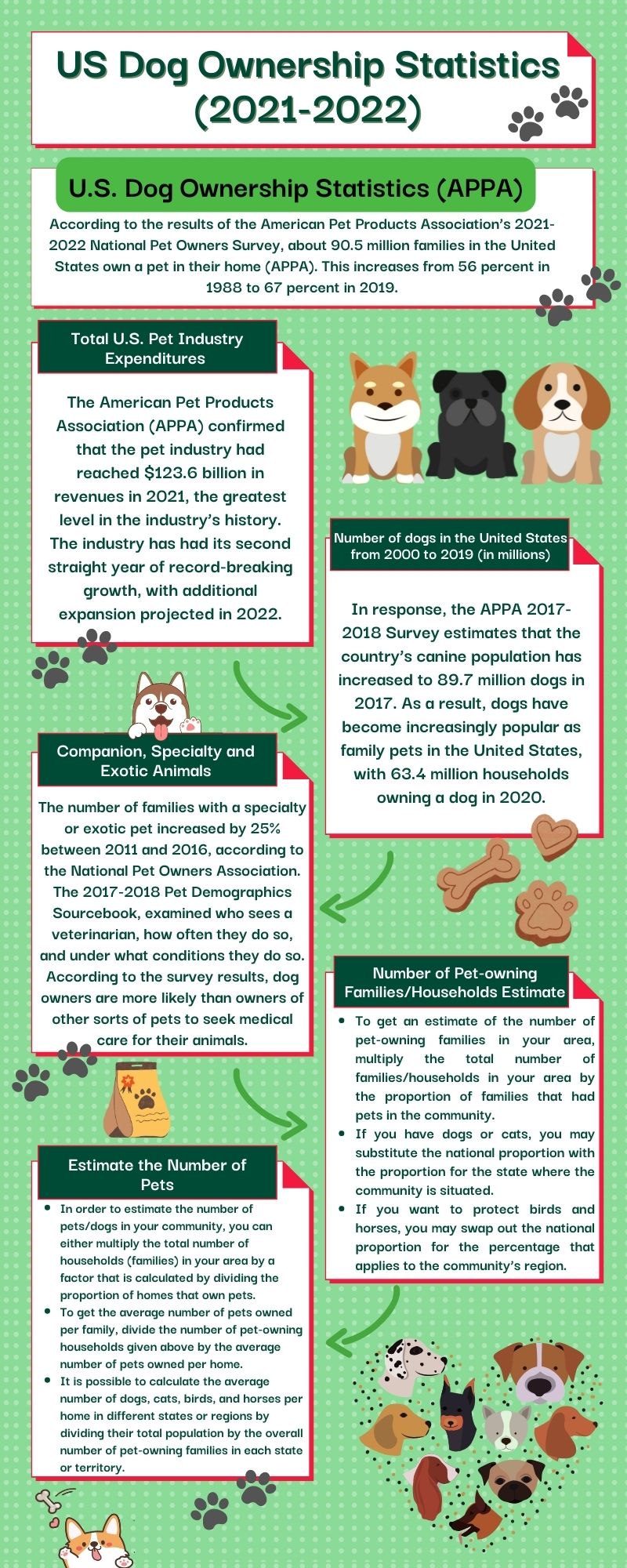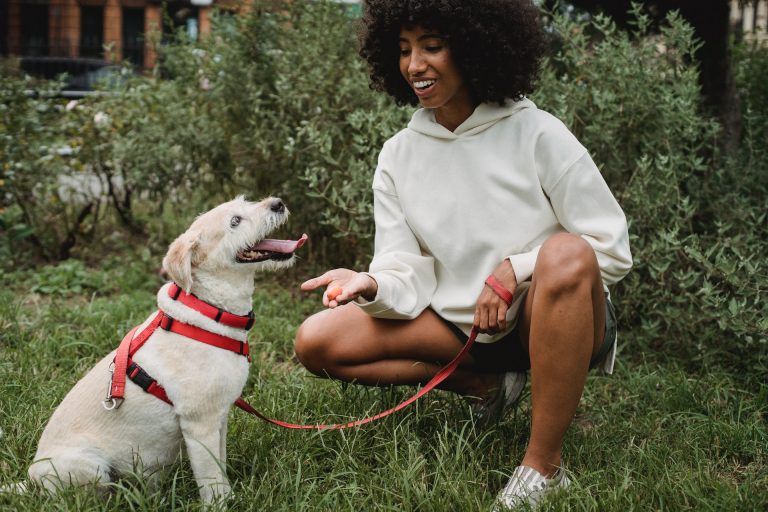US Dog Ownership Statistics – (2021-2022) Facts, Charts, and Tables
Pets have always been and will continue to be an integral part of the family. They may be a source of comfort, friendship, entertainment, and physical activity. Dogs, cats, birds, rabbits, and fish are among the most popular pets to have at home, but there are many others as well. It is estimated that a…
Pets have always been and will continue to be an integral part of the family. They may be a source of comfort, friendship, entertainment, and physical activity. Dogs, cats, birds, rabbits, and fish are among the most popular pets to have at home, but there are many others as well.
It is estimated that a high proportion of Americans across all age categories believe their pet to be their “fur-baby,” indicating that their pet plays an essential role in their life. So, here in this article, we will discuss everything about pet statistics, particularly dog statistics in the U.S.
Let’s start…
U.S. dog ownership statistics (APPA)
According to the results of the American Pet Products Association’s 2021-2022 National Pet Owners Survey, about 90.5 million families in the United States own a pet in their home (APPA). This increases from 56 percent in 1988 to 67 percent in 2019.
Total U.S. Pet Industry Expenditures
The American Pet Products Association (APPA) confirmed that the pet industry had reached $123.6 billion in revenues in 2021, the greatest level in the industry’s history. The industry has had its second straight year of record-breaking growth, with additional expansion projected in 2022.
<img src="https://dogperson.co/wp-content/uploads/2022/08/US-Dog-Ownership-Statistics-1.jpg" width="100%" alt="US Dog Statistics">
<a href="https://dogperson.co/us-dog-ownership-statistics/">
</a><p><strong>US Dog Statistics</strong>, courtesy of <a href="https://dogperson.co/us-dog-ownership-statistics/">The Dog Person</a></p>Following a record-breaking year in 2020, when the industry achieved sales of more than $100 billion for the first time, the American Petroleum Institute (APPA) predicted continued sales increase in 2021, estimating the growth of approximately 6 percent to bring overall sales to $109.6 billion by the end of the year. Actuals outperformed even the most optimistic forecasts, with a 13.5 percent year-over-year increase.
| Year | Billions of dollars |
| 2021 | $123.6 |
| 2020 | $103.6 |
| 2019 | $97.1 |
| 2018 | $90.5 |
Number of dogs in the United States from 2000 to 2019 (in millions)
Dog ownership in the United States has increased significantly since the turn of the millennium. Some years, such as 2002, saw a decrease in the number of dogs owned by families; in general, though, more and more households across the country have elected to add a dog to their family.
In response, the APPA 2017-2018 Survey estimates that the country’s canine population has increased to 89.7 million dogs in 2017. As a result, dogs have become increasingly popular as family pets in the United States, with 63.4 million households owning a dog in 2020.
Companion, Specialty and Exotic Animals
A greater number of people than ever before keep specialty or exotic pets such as fish, mice, bunnies, rodents, farm animals, guinea pigs, tortoises, reptiles as well as poultry, cattle, and amphibians.
The number of families with a specialty or exotic pet increased by 25% between 2011 and 2016, according to the National Pet Owners Association. The prevalence of chickens kept as pets have increased by 23 percent in the last five years, with poultry currently being kept as pets in 1.1 percent of all U.S. homes.
The 2017-2018 Pet Demographics Sourcebook, examined who sees a veterinarian, how often they do so, and under what conditions they do so. According to the survey results, dog owners are more likely than owners of other sorts of pets to seek medical care for their animals.
In 2016, the average number of visits to the veterinarian made by dog owners was three visits. Veterinary clients who own cats earned an average of 2.4 visits.
This graph shows the number of U.S. households that own companion/exotic pets (millions)
| Pet | Number | |
|---|---|---|
| Dog | 69.0 | |
| Cat | 45.3 | |
| Freshwater fish | 11.8 | |
| Bird | 9.9 | |
| Small animal | 6.2 | |
| Reptile | 5.7 | |
| Horse | 3.5 | |
| Saltwater fish | 2.9 |
Formulas for estimating the percentage of pet-owning households and pet population
Most towns do not have information on the number of families that own canines, cats, or other animals, nor do they have information on the number of these animals in their community.
Using the calculations provided below, it is possible to estimate the number of animal-owning households and animal populations in your neighborhood.
These algorithms will provide you with an estimate of the number of animal-owning homes and the number of pet populations in your area.
However, because these calculations are based on data from a sample poll, they should not be regarded as 100 percent correct in all cases.
In order to use the calculations below, you must first estimate the exact number of household members in which you are attempting to estimate the population.
In the absence of any other information, you may calculate the number of households in a community by dividing the total number of people living by the average number of people living in each home.
According to the Current Population Survey conducted by the United States Census Bureau in 2011, there were 2.6 members per family/household.
Number of Pet-owning Families/Households Estimate
- To get an estimate of the number of pet-owning families in your area, multiply the total number of families/households in your area by the proportion of families that had pets in the community.
- If you have dogs or cats, you may substitute the national proportion with the proportion for the state where the community is situated.
- If you want to protect birds and horses, you may swap out the national proportion for the percentage that applies to the community’s region.
Formulas for estimating the Number of Pet-owning Families/Households
| Dogs | Number of dog-owning households (families)= .384 x total number of households (families) |
| Cats | Number of cat-owning households (families) = .254 x total number of households (families) |
| Birds | Number of bird-owning households (families) = .028 x total number of households (families) |
| Horses | Number of horse-owning households (families) = .007 x total number of households (families) |
| All Pets | Number of pet-owning households (families) = .568 x total number of households (families) |
Estimate the Number of Pets
- In order to estimate the number of pets/dogs in your community, you can either multiply the total number of households (families) in your area by a factor that is calculated by dividing the proportion of homes that own pets.
- To get the average number of pets owned per family, divide the number of pet-owning households given above by the average number of pets owned per home.
- It is possible to calculate the average number of dogs, cats, birds, and horses per home in different states or regions by dividing their total population by the overall number of pet-owning families in each state or territory.
Formulas for estimating the number of pets
| Dogs | Number of dogs = 1.6 x number of dog-owning households (families)Number of dogs = 0.614 x total number of households (families) in your community |
| Birds | Number of birds = 2.1 x number of bird-owning households (families)Number of birds = 0.058 x total number of households in your community (families) |
| Horses | Number of horses = 2.1 x number of horse-owning households (families)Number of horses = 0.015 x total number of households (families) in your community |
| Cats | Number of cats = 1.8 x number of cat-owning households (families)Number of cats = 0.457 x total number of households (families) in your community |
Dog Statistics (Shelter Intake and Surrender)
- 3.3 million dogs enter shelters each year, according to the American Society for the Prevention of Cruelty to Animals (ASPCA).
- A total of 670,000 canines are euthanized out of this total.
- Fortunately, 1.6 million canines find permanent homes, and 620,000 dogs came into shelters as strays are reunited with their owners due to the shelter program.
- It should also be mentioned that animal shelters are frequently overcrowded during the holiday season, as people who get puppies and kittens as gifts are more likely to surrender them than to keep them.
Facts + Statistics: Dog Ownership and Insurance
Pet insurance is becoming increasingly popular as the number of pet owners grows. Pet insurance & property/homeowner insurance are two different types of insurance that may be purchased to cover your pet.
Let us discuss both
Pet Insurance
Along with obtaining proper homeowners/renters insurance, you may want to consider purchasing pet insurance as an extra layer of protection. Pet insurance, like conventional health insurance, is meant to cover medical expenditures for various situations ranging from consuming poison to repairing lacerations on a dog or cat.
While pet insurance is not required, having it may save you from paying unexpected veterinary expenditures out of pocket. It may be especially beneficial for pets that are prone to accidents or who have unique needs. Some breeds, such as English bulldogs, have a history of costly healthcare ailments, such as eye problems, which are common in this breed.
Comparing several pet insurance policies will assist you in finding the best value as well as the best match for your pet. The breed, age, weight, and pre-existing problems of your pet will all have an impact on the sort of insurance coverage that is most appropriate for you and your pet.
The following are some critical pet insurance statistics:
- The average yearly pet insurance cost for dogs is $600, and the average annual pet insurance premium for cats is $350.
- A total of 99 percent of all active pet insurance policies in the United States and Canada are held by pet health specialists and insurance firms that are members of the North American Pet Health Insurance Association (NAPHIA).
- According to the National Association of Pet Insurance Administrators, about 3.45 million pets will be insured in North America by the end of 2020.
Homeowners insurance
Pet insurance is designed to cover the expenses of medical costs for your dog, whereas a homes or renters insurance coverage will cover the costs of medical bills resulting from a pet bite.
Physical damage caused by your pet (such as teething or scratching) is not covered by homes insurance plans; however medical expenses incurred as a consequence of someone being bit or scratched by your pet are covered by homeowners insurance policies.
It’s a good idea to evaluate the liability limitations of your home or renters insurance policy before bringing a new pet home in case someone else is hurt by your dog while visiting your house.
The following are some critical property/homeowner insurance statistics:
- According to the American Society of Cosmetic Surgeons, about 47,000 procedures for dog bite repair will be done by plastic surgeons in the United States in 2020.
- In the United States, according to the American Veterinary Medical Association, children are the most prevalent victims of dog attacks.
- Approximately one in every five persons who a dog bites will require medical intervention.
It is an excellent approach to infuse your home with enthusiasm and pleasure by welcoming a new pet into your family or household. But doing so involves a significant financial commitment, which includes one-time charges as well as regular recurrent expenses.
It is necessary to consider medical care and food expenditures in addition to adoption costs when determining how much money to spend. As a result of the financial responsibilities associated with keeping a pet, it may be wise to check into additional coverage, such as adding dog insurance to your homes or renters’ insurance policy.
It is possible to guarantee that both your and your pet’s requirements are satisfied by properly arranging for a pet in advance.
Top 10 States with the Highest Percentage of Dog Owners
Top 10 states with the highest percentage of dog owners are:
- Montana: 52%
- Arkansas: 52%
- Mississippi: 51%
- Est Virginia: 50%
- Indiana: 49%
- Oklahoma: 48%
- Nebraska: 47%
- Tennessee: 47%
- Alabama: 47%
- Kentucky: 47%
Top 10 States with the Lowest Percentage of Dog Owners
The top 10 states with the fewest dog owners are
- Illinois: 32.4%
- New Jersey: 32.3%
- Minnesota: 31.9%
- Maryland: 30.7%
- New Hampshire: 30.2%
- Utah: 29.4%
- Rhode Island: 29.3%
- New York: 29%
- Connecticut: 28.3%
- Massachusetts: 23.6%
Global Top 8 Dog Breeds with AKC Ranking for Comparison
Here are the most prevalent top 8 dog breeds in the USA
- Mixed Breed
- Chihuahua
- Yorkshire Terrier
- Labrador Retriever
- Golden Retriever
- German Shepherd
- Dachshund
- Shih Tzu
These eight breeds are most common in America, but what about the rest of the world? There are some significant distinctions between the most popular dog breeds in the United States and the most popular dog breeds around the globe.
According to the American Kennel Club, the Bulldog is now the most popular dog in the world, yet it ranks fourth in the United States.
The breed is particularly popular among canine owners in the United Kingdom, Hungary, and the United States. Meanwhile, the adored Labrador Retriever, which is ranked first in the AKC list, is only 3rd in the world, with the AKC second solid in its position even in the global rankings.
The Husky, Bulldog, and Chihuahua are also given a significant boost, even though they are not even in the top ten of the American Kennel Club’s rankings.
Cost of Keeping a Dog
The annual expense of having a dog is estimated to be between $1,500 and $9,900. Depending on your decisions, there are several methods to save money. Other considerations to consider are the size and age of your dog, the location in which you reside, your personal lifestyle, and the specific demands of your dog, among others.
Basic Costs of Owning a Dog
| Type of Expense | Yearly Estimate |
| Food and Treats | $250 to $700 |
| Toys | $25 to $50 |
| Beds | $50 to $200 |
| Leashes and Collars | $20 to $50 |
| Grooming | $30 to $500 |
| Routine Veterinary Care (healthy dog) | $700 to $2,000 |
| Preventative Medications and Supplements | $200 to $600 |
| Training Classes or Resources | $25 to $300 |
| Dog Walking (between $0 (you can walk your dog) up to $20 per walk, 1x per weekday) | $0 to $5,200 |
| Petsitters or Boarding | $100 to $300 |
| Average Monthly Cost of Owning a Dog | $125 to $824 |
| Yearly Total | $1,500 to $9,900 |
COVID-19 impact on dog ownership
The coronavirus pandemic has substantially impacted a wide range of businesses, including the pet-care industry. According to a study conducted in November 2021, 14 % in the United States stated that they had just acquired a new pet. This represents an increase of four percent when compared to December 2020, when 10 % of respondents indicated that they had received a new animal companion.
Individuals from all generations reported spending a lot of time with their dogs due to public distancing restrictions, which were implemented countrywide in 2020 and forced people to spend the majority of their time at home.
Aside from that, the pandemic influenced the economic well-being of millions of people who may have suffered from unstable jobs or part-time employment that was terminated due to lockdowns, which caused many pet owners to worry about the pricing of pet food and other supplies.
In fact, today’s youth in the United States, such as Generation Z and Millennials, were more concerned about pet expenditures during the coronavirus epidemic in 2020 than Baby Boomers.
Pet industry in the United States
The number of dogs owned worldwide surpassed 471 million in 2018. Over 38 percent of families in the United States have dogs, with each family having an average of 1.6 dogs.
Males were more likely than females to possess dogs, and those between the ages of 18 and 29 were the most likely to own a dog.
It is possible that the prevalence of female and male dog owners stems from their childhood experiences with dogs, which might explain their preference for canine companions in part.
Over two-thirds of Americans (or 65 percent) own at least one household pet, with dogs being perhaps the most popular breed across all generations in the United States (48 percent). Dogs were the most favorite pets among millennials, accounting for 61 percent of respondents.
Furthermore, many Americans sought solace in their dogs’ company throughout the epidemic.
According to a poll, 15 percent of Americans reported that they had obtained a dog during the pandemic in some way, like through a pet shelter, animal welfare, or rescue group.
Dog Population & Dog Sheltering Trends in the United States of America
There are no nationwide estimates of the demographics of dogs leaving and entering shelters in the U.S. In the meantime, there are a plethora of data sources that all indicate a significant decrease in the number of dogs (and cats) joining shelters in the United States.
According to data gathered by the American Naturalists’ Association (ANR) throughout the years, the following figure depicts what has occurred in U.S. shelters since 1970. Merritt Clifton, the only other individual who has attempted to track shelter animal populations over the previous 50 years, thinks that more than 100 cats & dogs per 1,000 people entered shelters in 1970, according to Clifton’s calculations.
The Success of Sterilization and Differentiated Dog Licensing in the United States of America
In 1973, the Humane Society of the United United States (The HSUS) estimated that approximately 13.5 million animals (64 dogs and cats per 1000 people) were euthanized (peaceful killing) in the United States (approximately 20% of the pet population) and that about 25% of the dog population was still roaming the streets in the United States.
The number of animals taken in and euthanized (at the national and state levels) decreased dramatically in the 1970s as a result of a variety of factors, including the application of sterilization policies by animal shelters, modifications in sterilization practices by private veterinarians, and the quotation of local ordinances trying to implement differential licensing fees for intact and sterilized animals.
During the 1980s, the number of animals admitted to shelters had decreased by almost 50% (the Humane Society of the United States estimated that 7.6–10 million animals were killed in 1985). Adoptions have risen in the previous decade, according to data gathered by PetPoint over the past eight years.
This may be a contributing factor to recent euthanasia decreases in the United States. A significant contribution to the cultural shift in the United States may have come from sterilizations, which are now considered standard veterinary care, as well as the level of control over pet dogs exercised by pet owners (roaming dogs are now almost entirely absent from many U.S. communities). A larger majority of households now regard their pet dogs as “family members,” according to PetPoint.
References
- https://www.frontiersin.org/articles/10.3389/fvets.2021.781403/full
- https://www.nature.com/articles/s41598-022-10019-z
- https://spots.com/pet-ownership-statistics/
- https://www.bankrate.com/insurance/homeowners-insurance/pet-ownership-cost-statistics/
- https://www.avma.org/resources-tools/reports-statistics/us-pet-ownership-statistics
- https://www.thesprucepets.com/the-cost-of-dog-ownership-1117321
- https://www.akc.org/expert-advice/news/most-popular-dog-breeds-full-ranking-list/
- https://www.akc.org/expert-advice/lifestyle/how-much-spend-on-dog-in-lifetime/
- https://www.iii.org/fact-statistic/facts-statistics-pet-ownership-and-insurance
- https://www.avma.org/news/press-releases/avma-releases-latest-stats-pet-ownership-and-veterinary-care
- https://worldpopulationreview.com/state-rankings/pet-ownership-statistics-by-state
- https://www.safewise.com/blog/safest-states-pets/
- https://www.statista.com/statistics/1294009/top-states-for-dog-ownership-rates-us/
- https://dogtime.com/trending/17160-us-states-with-most-and-fewest-pet-owners-named
- https://www.statista.com/topics/1258/pets/#dossierKeyfigures
- https://www.washingtonpost.com/science/2019/01/31/how-many-americans-have-pets-an-investigation-into-fuzzy-statistics/
- https://www.aspca.org/helping-people-pets/shelter-intake-and-surrender/pet-statistics
- https://www.statista.com/topics/1258/pets/#dossierContents__outerWrapper







